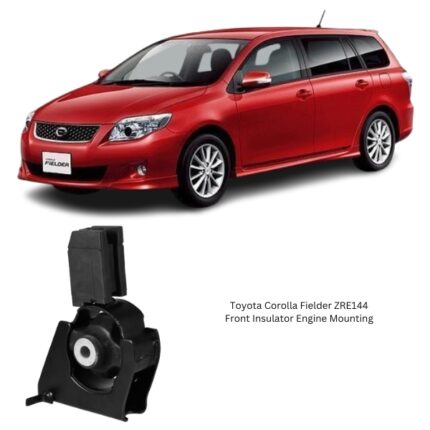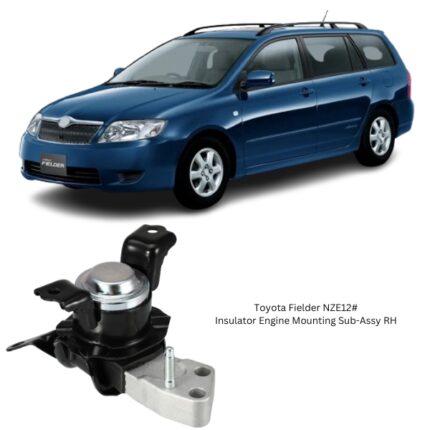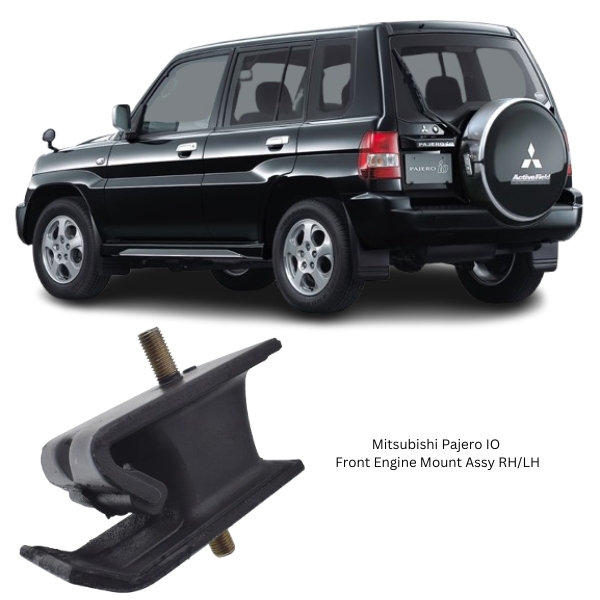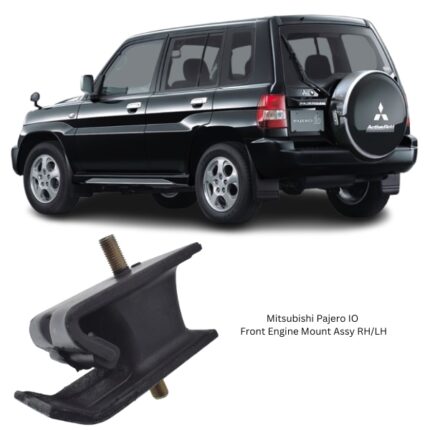Get Mitsubishi Pajero IO Front Engine Mount Assy RH/LH MR319769 in Kenya
The Front Engine Mount Assembly RH/LH is a vital structural and vibration-damping component in a vehicle’s engine support system. Positioned on both the right-hand (RH) and left-hand (LH) sides at the front of the engine bay, these mounts play an essential role in securing the engine to the vehicle’s chassis while isolating vibrations, minimizing torque-induced motion, and maintaining proper engine alignment.
As engines operate under continuous cycles of combustion, acceleration, and deceleration, they generate substantial movement and force. Engine mounts—particularly the front right and left mounts—are strategically engineered to absorb these dynamic forces and prevent them from being transmitted into the cabin or damaging surrounding components. When in good condition, these mounts contribute directly to ride comfort, engine stability, and mechanical longevity.
Primary Function and Importance
The Front Engine Mount Assembly RH/LH serves multiple roles, each critical to the safe and efficient functioning of the vehicle:
-
Structural Support: Carries and distributes part of the engine’s weight, helping to hold the engine firmly in place under all driving conditions.
-
Vibration Damping: Absorbs engine-generated vibrations, ensuring they are not transferred to the vehicle frame or interior.
-
Torque Reaction Control: Manages twisting or rocking motions of the engine during acceleration, braking, or gear shifting.
-
Maintaining Alignment: Ensures that the engine and transmission remain aligned with the driveline, preventing stress on drivetrain components.
-
Component Protection: Reduces wear and strain on nearby parts such as exhaust systems, wiring harnesses, cooling hoses, and axles.
By performing these functions, the mounts preserve the integrity of the engine support system and enhance overall vehicle performance.
Construction and Material Composition
The Front Engine Mount Assembly RH/LH is constructed with high-strength materials engineered to resist wear, fatigue, and environmental damage.
Core Components:
-
Mounting Bracket
The bracket is typically fabricated from forged steel, cast aluminum, or stamped heavy-duty metal. It anchors the mount to the engine and chassis and provides structural rigidity. -
Rubber or Elastomeric Core
The central vibration-damping component is made from natural rubber or polyurethane elastomer, chosen for its flexibility and resistance to heat, oil, and aging. -
Metal Sleeve or Center Bushing
A central metal insert passes through the rubber core, providing a path for the mounting bolt and distributing torque loads uniformly. -
Hydraulic Damping Chamber (Optional)
Some mounts feature a fluid-filled internal chamber for superior damping of low-frequency engine vibrations, particularly at idle. -
Anti-Corrosive Finish
Protective coatings resist rust and chemical exposure, ensuring longevity in harsh engine bay environments. -
Thermal Shield (in certain designs)
A heat deflector or insulator may be included to shield the rubber from radiant engine or exhaust heat.
This multi-material design allows the mount to withstand temperature fluctuations, chemical exposure, and mechanical stress throughout its service life.
Performance Characteristics
Engine mounts—especially the front RH and LH assemblies—are tested and optimized for durability and performance. When functioning correctly, they provide the following:
-
Precision Engine Positioning: Holds the engine in the correct position to align with transmission, axles, and support systems.
-
Isolation of Vibrations: Effectively reduces vibrations transmitted into the cabin and steering system.
-
Reduction of Engine Rock: Limits the amount of engine rotation under torque, preserving the health of transmission and mounts.
-
Longevity Under Load: Withstands repetitive stress from acceleration, braking, cornering, and road vibrations.
-
Noise Reduction: Minimizes humming, thumping, or droning sounds caused by engine movement or misalignment.
Common Signs of Failure
Over time, the Front Engine Mount Assembly RH/LH may degrade due to wear and tear, fluid exposure, or heat. A failing mount can lead to reduced comfort and mechanical issues. Common signs of failure include:
-
Excessive Vibration
Increased engine vibration may be felt through the steering wheel, floorboards, or seats, especially when idling or accelerating. -
Clunking or Banging Noises
A failing mount may cause the engine to move excessively, resulting in audible knocking or thudding sounds during gear shifts or over bumps. -
Engine Rocking or Tilting
Observed movement of the engine when revving or shifting gears, indicating insufficient support. -
Visible Wear or Damage
Cracks, separations, or collapsing rubber in the mount body or signs of oil saturation indicate deterioration. -
Misaligned Engine Components
Poor alignment of belts, pulleys, or hoses can result from engine sag caused by a damaged mount. -
Fluid Leaks (if hydraulic)
In hydraulic mounts, leaking fluid is a clear sign of internal failure and loss of damping capability.
Installation Overview
Replacing the front RH or LH engine mount requires proper tools and safety precautions. The basic procedure includes:
-
Vehicle Preparation
Secure the vehicle on a level surface. Disconnect the battery and lift the vehicle if necessary. -
Support the Engine
Use a hydraulic jack with a block of wood or an overhead engine support bar to bear the engine’s weight while removing the old mount. -
Remove Obstructing Components
Remove engine covers, air filters, or brackets that may block access to the mounts. -
Unbolt the Existing Mount
Carefully unbolt the mount from both the engine and chassis/frame. -
Inspect Surrounding Components
Check the condition of neighboring mounts, hoses, and brackets. -
Install the New Mount
Align and insert the new mount, securing all bolts to the specified torque. -
Double Check Alignment
Ensure the engine remains level and aligned after installation. -
Test the Vehicle
Start the engine and observe for abnormal movement, vibration, or sounds. Take the vehicle for a short test drive to confirm performance.
Maintenance and Inspection Tips
Although engine mounts are typically maintenance-free, regular inspection can prevent failures:
-
Inspect rubber for cracks, splitting, or collapse
-
Check for oil contamination, which can weaken the rubber compound
-
Ensure bolts are tight and secure
-
Look for fluid leaks in hydraulic designs
-
Monitor for engine misalignment or movement under load
Routine checks during oil changes or suspension service can catch issues early.
Benefits of Replacing a Worn Mount
-
Enhanced Comfort: Restores factory-level vibration isolation and driving smoothness.
-
Improved Safety: Prevents unexpected engine movement during driving.
-
Protection of Engine and Transmission: Preserves proper alignment and reduces stress on drivetrain components.
-
Quieter Operation: Eliminates knocks, clunks, or excessive noise from engine movement.
-
Extended Vehicle Life: Maintains the condition of related systems, such as the exhaust, wiring, and cooling hoses.
Follow us on Facebook for more parts.





Reviews
Clear filtersThere are no reviews yet.